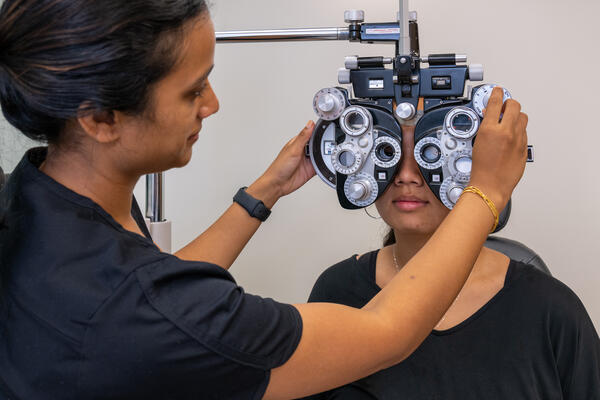Practical Glaucoma Service Near Me: Browse Through Our Experienced Clinic
Practical Glaucoma Service Near Me: Browse Through Our Experienced Clinic
Blog Article
Discovering the State-of-the-Art Technologies Made Use Of for Dealing With and detecting Eye Conditions
In the realm of ophthalmology, the evolution of modern technology has actually considerably enhanced the devices offered for diagnosing and dealing with different eye conditions. From advanced imaging technologies that provide detailed understandings into eye frameworks to robotic-assisted surgeries that use unmatched accuracy, the landscape of eye care is frequently developing. With the integration of fabricated intelligence in diagnostics, genetics therapy advancements, and virtual fact rehabilitation, the opportunities for improving person results are increasing at a rapid rate. The convergence of these advanced modern technologies holds the pledge of revolutionizing the field of ophthalmology, supplying new methods for personalized and efficient therapies.

Advanced Imaging Technologies
Advanced Imaging Technologies have changed the field of ophthalmology by offering detailed and exact visualization of the eye structures. Optical Comprehensibility Tomography (OCT) stands out as a vital technology in this world. OCT utilizes light waves to catch high-resolution cross-sectional pictures of the retina, enabling the recognition of minute architectural changes. This non-invasive strategy help in the early discovery and surveillance of various eye problems such as macular degeneration, diabetic retinopathy, and glaucoma.
Additionally, Fundus Digital photography is an additional important tool in sensory imaging. This method entails capturing comprehensive photos of the rear of the eye, consisting of the retina and optic disc. Fundus Digital photography aids in recording the progression of eye diseases, assessing therapy efficacy, and informing individuals regarding their eye wellness.

Robotic-Assisted Operation
Robotic-assisted operations have considerably advanced the abilities of ophthalmic surgical treatment, introducing a brand-new period of accuracy and efficiency in dealing with numerous eye conditions. By incorporating robotic modern technology right into operations, eye doctors can accomplish unmatched precision and control, leading to enhanced individual end results.
One of the key benefits of robotic-assisted surgical treatment in ophthalmology is the improved dexterity and security it provides to specialists. The robot arms can perform precise motions with a high degree of precision, permitting fragile procedures with very little invasiveness. This degree of precision is particularly helpful in surgical procedures including the retina, where even minor mistakes can have considerable implications for a client's vision.
In addition, robotic-assisted surgical systems give real-time imaging and feedback to the surgeon, allowing them to make educated decisions throughout the procedure. This technology improves the specialist's situational understanding and enables changes to be made promptly, ensuring optimum outcomes for the patient.
Artificial Knowledge in Diagnostics
With the development of cutting-edge modern technologies enhancing surgical precision in ophthalmic procedures, the combination of Artificial Intelligence in diagnostics has actually arised as a pivotal advancement transforming the area of eye treatment. Synthetic Intelligence (AI) formulas are being progressively Clicking Here made use of to analyze complex data from imaging technologies like optical comprehensibility tomography (OCT) and fundus digital photography to help in the very early detection and accurate diagnosis of different eye problems. These AI systems can successfully recognize patterns and anomalies in images that might not be discernible to the human eye, making it possible for quicker diagnosis and treatment preparation.
AI formulas can additionally forecast condition progression, suggest individualized treatment strategies, and assess the efficiency of treatments. By simplifying the analysis procedure, AI find more information not just enhances the effectiveness of eye treatment experts but also enhances person end results by enabling timely treatments. As AI continues to breakthrough, its role in diagnostics is expected to increase, offering new possibilities for very early intervention and personalized treatment in the field of ophthalmology.
Genetics Treatment Innovations
In the realm of ocular developments, current strides in genetics treatment innovations have stimulated substantial passion among researchers and healthcare specialists alike. Gene treatment holds enormous promise in transforming the treatment of numerous eye problems by targeting the underlying genetic reasons. By presenting genetic product into cells to compensate for abnormal genes or to provide an absent genetics, gene treatment offers a customized technique to addressing inherited eye problems such as retinitis pigmentosa, Leber congenital amaurosis, and others that were formerly considered untreatable.

As study in gene treatment proceeds to breakthrough, the capacity for tailored therapies for a wider series of eye conditions grows, using new hope for individuals with hereditary eye diseases.
Online Fact Rehabilitation
Digital fact rehabilitation has become an advanced method in improving the healing and recovery procedures for people with numerous aesthetic impairments. retina service near me. By simulating real-world environments with immersive modern technology, virtual truth supplies a special system for vision treatment and recovery. This ingenious technique makes it possible for people to involve in interactive exercises and tasks made to improve aesthetic acuity, deepness assumption, eye control, and total aesthetic functioning
One key benefit of digital fact recovery is its ability to customize therapy programs based on the specific needs and abilities of each patient. With real-time feedback and tracking, health care professionals can track progression, adjust treatments, and give individualized like enhance results. Furthermore, virtual truth technology can develop a secure and controlled room for individuals to exercise visual tasks, get over challenges, and build self-confidence in an online setup prior to transitioning to real-world scenarios.
Verdict
In final thought, the developments in imaging modern technologies, robotic-assisted surgical treatments, expert system diagnostics, gene treatment innovations, and online reality rehabilitation have dramatically boosted the diagnosis and therapy of eye problems. refractive surgeries in al. These modern modern technologies have actually transformed the field of ophthalmology, enabling for more efficient and accurate treatments. As technology proceeds to develop, the future of eye care looks appealing with the possibility for much more ingenious remedies to boost individual these details end results
In the realm of ophthalmology, the development of technology has actually dramatically enhanced the tools readily available for identifying and dealing with different eye conditions. Fundus Photography aids in documenting the progression of eye conditions, reviewing therapy efficacy, and educating people about their eye health and wellness.
Synthetic Intelligence (AI) algorithms are being significantly used to examine complex information from imaging innovations like optical coherence tomography (OCT) and fundus photography to aid in the very early discovery and accurate medical diagnosis of numerous eye conditions.In final thought, the advancements in imaging innovations, robotic-assisted surgeries, synthetic intelligence diagnostics, gene therapy advancements, and digital reality rehabilitation have actually significantly boosted the diagnosis and treatment of eye problems. As innovation continues to advance, the future of eye treatment looks promising with the potential for even more ingenious services to enhance individual outcomes.
Report this page